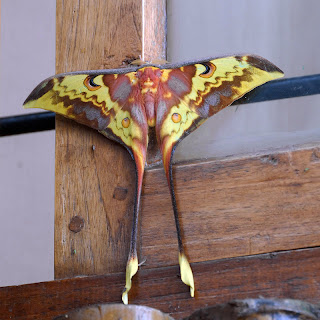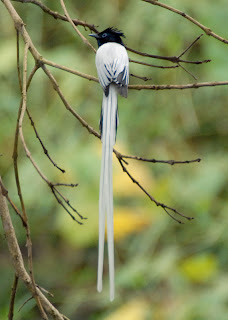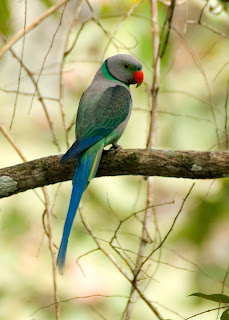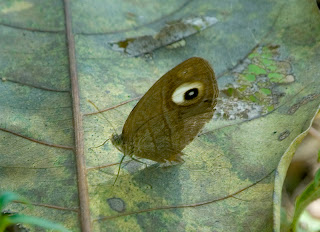
Four. Four hairs poked out of his right nostril, but I was not going to chide him for his disregard for personal coiffure. I was more focused on leaping forward to escape the tip of his horn from perforating me. Yes, the perils of birding on foot can easily classify it as an extreme sport, the truth of which was being unravelled to me by the huge Indian Gaur bull in the Karian Shola rainforest of Anaimalai.
 |
| Gaur |
Mr. Bos gaurus was watching us go down a slope towards a fig tree purported to be laden with Great Hornbills one wintry evening in January 2010, and decided to charge us for this transgression. My nimble footwork ensured that I am writing this report, and as the thundering hooves plunged down the hillock, I remember our guide Kethan emerging from the depths of a thorny bush into which he had wisely retreated, and congratulating me on my good luck.
“Last week, one of the tribals got squashed against a tree by a charging Gaur, saar!”, he added breezily, providing succour to my trembling innards. My wife Sarita, who was a few yards behind us, had a bird’s-eye view of the entire gory proceedings, and proceeded to inspect me for blood and gaur. Once she was satisfied that there was no damage to my vital installations, and that I could still use a fig leaf, we proceeded to the aforementioned Ficus.
 |
| Nilgiri Langurs |
The Karian Shola is a amazing evergreen forest, deep, dark, untouched. Barely a couple of kilometres away from the Topslip camp, it makes for an easy walk through the moist forest floor. A White-eye Buzzard gave us the glad eye before we slipped under the canopy, and a group of Nilgiri Langurs were convinced that we were trying to ape their ways. The weather outside was nippy, but in here, the air turned muggy and musky. A sweet medicinal scent wafted through, and we soon broke into a sweat keeping up with Kethan. We reached a scenic clearing, with a gentle stream flowing past, and a small watchtower generally keeping an eye on things.
 |
| Flamethroated Bulbul |
We were immediately rewarded by a Flame-throated Bulbul cozying up his to his old flame. A Crimson-fronted Barbet looked rather red-faced at the proceedings, and a pair of Malabar Grey Hornbills cackled derisively like judges in one of the innumerable Laughter Challenge shows. A Greater Flameback provided the drumrolls, but Kethan promised us that the best of the endemics was yet to come.
He swung us off the track into a thicket, pointed to a couple of dry leaves swaying in the breeze, and announced, “Frogmouth”. Sarita and I craned our necks, squinted into the foliage, and looked at each other – was Kethan puling a fast one here? I even put on my reading glasses, but to no avail. Kethan took a deep breath and sighed – the sigh he uses when he feels he’s dealing with particularly moronic guests, and pointed to the two leaves. I looked at them through my binoculars, and the leaves morphed into an avian form I had never seen before – a pair of Srilankan Frogmouths!
 |
| Srilankan Frogmouth |
I set up my camera stealthily (unnecessary, said Kethan), and clicked away as Sarita discovered these brilliantly camouflaged birds which were barely three yards away (maybe I should’ve used my reading glasses right in the beginning). Rare, endangered, inscrutable – the very qualities they share with the Karian Shola, I observed.
I was up at 6 am the next morning, but Topslip was in dream sequence mode – misty and mysterious, with no movement of bird, man or beast, just the distant calls of a Common Hawk Cuckoo and a Malabar Whistling Thrush permeating through the blanket. A bare bulb burning outside our room had attracted all the local moths, and I gasped when I saw ‘Ikraan’ – a name borrowed from the movie ‘Avatar’, where a colourful Archaeopteryx-like flyer was so named. I quickly pulled Sarita out of bed to witness this spectacular creature, which I later learnt is called the Sonthonnaxia maenas, a rare moth from the Moon Moth family.
 |
| "IKRAAN" |
An Atlas Moth snuggled nearby, carrying his own burden of being India’s largest moth, while scores of smaller moths sought solace from the bulb. A Malabar Whistling Thrush soon landed up to feast on the moth buffet (reminded me of the dialogue from Sholay – “ Moth tere sar pe mandraa rahi hai, kaalia!”).
 |
| Malabar Whistling Thrush |
Seeing Sarita, he launched into an impromptu serenade (the little rascal), but left his wolf whistle for later. He made repeated forays till he had consumed the moth-er of all breakfasts, and faded away into the mist. A Grey Junglefowl announced that it was 9 am, and we proceeded for our breakfast.
Kethan suggested that we go downhill towards Ambuli, where the mist would lift soon, and we fell in line. The mist did start thinning out, and the bird activity picked up. A White-cheeked Barbet initiated the rabble-rousing, and a pair of Whitebellied Treepies tooted their approval.
 |
| Whitecheeked Barbet |
 |
| Paradise Flycatcher |
A male Paradise Flycatcher looked for heaven, not knowing it was firmly stuck to his backside. An Asian Fairy Bluebird waved her wand, and a pair of Blackheaded Bulbuls made their appearance. We startled a group of Sambhar deer basking on a rock, and we had unknowingly rocked their boat. A couple of Yellow-browed Bulbuls raised their brows in censure, though we couldn’t quite understand the Darkfronted Babblers as they were babbling. A large clearing beckoned, and we decided to explore its potential.
 |
| Malabar Parakeet |
A few Malabar Parakeets foraged in a bush, occasionally screeching their disapproval at our unpalatable presence. A Pompadour’s Green Pigeon preened herself pompously, while a Malabar Woodshrike came to check if we had updated his new name in our birdlist. A Crested Tree Swift looked crestfallen, until he swiftly spied his mate hiding in a leafy branch. A female Orange Minivet looked for the apple of her eye, who seemed to have gone off after Scarlett. Several unidentifiable avians darted from one bush to the other, reminding me of the ‘here a chick, there a chick, everywhere a chick-chick’ part of the Ol’ McDonald verse. A flock of Blackthroated Munias landed on a shrub, but most seemed to be juveniles, not showing their true colours. We trudged back to boot camp behind Sergeant Kethan, and encountered the Draco, or gliding lizard right next to our digs. Two males were battling it out for the lone female, flashing their yellow throat appendage, and one eventually emerged with flying colours, and proceeded to take his maiden flight with the winsome lass. A Bronzeback Tree Snake impersonating a branch took a laidback view of his reptilian cousins’ dalliances, and forgave them as they were just working on the family tree.
 |
| Draco |
A sounder of the local Wild Boar grunted their goodbyes as we pulled out of Topslip, and onto Parambikulam Wildlife Sanctuary, a long journey of 3 kilometres.
Parambikulam
 |
| Velvetfronted Nuthatch |
Literally down the road from Anaimalai lies the small sanctuary of Parambikulam, falling in Kerala state, and like true Mallus, we contemplated kissing the ground after crossing the Anapadi checkpost (the elephant-dung strewn around made us wisely refrain). Three large dams create their backwaters which dominate the Parambikulam landscape, and we were to stay at Thunakadavu overlooking the water. Upon learning of our interest in birds, the helpful staff at the orientation centre suggested that we stay put at the Anapaadi Tented Camp, as it is apparently a known haven for birds, and is close to the local birding hotspots. We looked around, and as if on cue, an Orange Minivet, a Velvet-fronted Nuthatch and a Brown-capped Pygmy Woodpecker emerged from the woodwork to lend credence to the claim. Quelling our suspicion that these were from the Anapadi Marketing Dept., we checked into our modest tent.
Lunch was divine, given the liberal use of coconut in the curries (O Kerala!), and we were bundled into the camp bus for the evening’s outing. We passed a few ‘wayals’ or swampy meadows, where herds of Gaur boldly foraged – after the previous day’s tete-a-tete with the gaur bull, I refrained from looking them in the eye, and we moved on. Our first halt was at the Kannimara teak tree, a colossus amongst the teak trees dominating the area. Local tourists swarmed around, displaying their simian best, and we gestured to our driver to deliver us unto more peaceful climes.
 |
| Darter |
The Thunakadavu reservoir was impressive, and a Darter stood frozen in the water. Rufous Babblers called from the labyrinth of a bamboo brake, but refused to reveal themselves. Greyheaded Fishing Eagles were promised, but were evidently casting their net elsewhere. We moved onwards up the hilly terrain to the Parambikulam reservoir, a gleaming sheet of water encased by impenetrable forest. We were bundled into indigenous bamboo rafts for a scenic boat ride, and we floated down the serene backwaters. A pair of Whitebrowed Wagtails cavorted on a floating log, and a flock of Litle Egrets did an elegant fly past. A small island passed by, one of its trees laden with Malabar Whiteheaded Mynas discussing their newfound freedom from the Chestnut-tailed Starlings. The boatman pointed out to a distant island called Veettikunnu emerging like an emerald isle from the blue waters – the Forest Dept. lets out one room on the island for adventurous guests wishing to emulate Robinson Crusoe, and provides Men Fridays too!
 |
| Parambikulam reservoir |
The aroma of freshly brewed coffee propelled us into one of the stalls lining the road back at the Parambikulam settlement, and we indulged ourselves as the elderly lady manning the stall plied us with wildlife stories to accompany the brew. Elephants mill around the town square at night as if it were a social networking site, she claimed, but they had thankfully spared her stall till date. A Wild Boar sow with her ‘boarlets’ in tow chased off a terrified dog hovering around the stall to remind us that this was indeed a wild area, once the thin veneer of civilisation was off. Speaking of wild stuff, we were obliged to witness a tribal dance as part of the day’s programme – the all-woman cast put up a spirited show in spite of the desultory male percussionists.
Spotlights were employed on the drive back, and we saw several herds of Gaur enjoying a high-speed browsing experience. A Common Palm Civet trudged along the road in no haste, looking for some finger foods to start the evening with (who knows what we saw, it may have even been the near-extinct Malabar Civet – all cats and civets look the same in the dark, to borrow an old saw). An Oriental Scops Owl surveyed his prey base from a strategic perch, and we exchanged a friendly Ook....krook krook with him. A nightjar flew across, probably finding the headlights too jarring, and refused to reveal his ID. Blacknaped Hares leapt around, trying to keep pace with the tortoises, while unidentified rodents joined the rat race.
 |
| Flying Squirrel ;-) |
 |
| Black baza |
 |
| Karianshola |
 |
| Gladeye Bushbrown |
 |
| Common Indian Toad |
 |
| Greater Rackettailed Drongo |
The camp precincts yielded a heart-stopping moment in a Heartspotted Woodpecker doing his morning cardio, and all able hands were called upon to assist in tracing his ECG-like flight path. A tiny black-and-white bird up in the canopy challenged our birdbrains, and we realised that it was a tit like no other – a Whitenaped Tit, which is generally found in the Acacia forests of Gujarat – reflecting, perhaps, the Gujaratis’ penchant for travel! Shanmugan mentioned that they were perplexed too, and have been seeing this visitor since the last few weeks: I consoled him by saying that if the Gujaratis have discovered this place, more of their ilk will follow, and obviously, the more tits the merrier!
 |
| Malabar Giant Squirrel |
******************************************